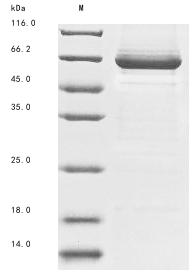Recombinant Saccharomyces cerevisiae Alpha-1,3-mannosyltransferase MNT3 is produced using the baculovirus expression system, covering the amino acid region 32-630. This partial protein includes an N-terminal 10xHis-tag, which helps with purification and detection. SDS-PAGE analysis confirms the protein maintains a purity level greater than 85%, making it suitable for various research applications that require high-quality reagents.
Alpha-1,3-mannosyltransferase MNT3 appears to be an enzyme involved in glycosylation processes within Saccharomyces cerevisiae. It plays what seems to be a critical role in modifying glycoproteins by adding mannose residues—a key step in synthesizing complex carbohydrates. This protein may offer valuable insights into understanding how glycan assembly works and how it's regulated, potentially shedding light on cellular processes and pathways that glycosylation influences.
Potential Applications
Note: The applications listed below are based on what we know about this protein's biological functions, published research, and experience from experts in the field. However, we haven't fully tested all of these applications ourselves yet. We'd recommend running some preliminary tests first to make sure they work for your specific research goals.
Saccharomyces cerevisiae MNT3 is a Golgi α-1,3-mannosyltransferase that requires precise folding, proper transmembrane domain organization, and specific catalytic site formation for its enzymatic activity in mannan biosynthesis. The baculovirus expression system provides a eukaryotic environment that supports proper folding, disulfide bond formation, and post-translational modifications. However, the partial fragment (32-630aa) may lack the N-terminal transmembrane domain (approximately first 30-40 amino acids) that anchors the protein to the Golgi membrane, which is crucial for its proper orientation and function. The N-terminal 10xHis-tag is relatively small and unlikely to cause significant steric interference. While the catalytic domain is likely intact, the probability of correct folding with functional mannosyltransferase activity requires experimental validation due to the missing transmembrane region.
1. In Vitro Mannosyltransferase Activity Assays
This application carries a significant risk without functional validation. MNT3 enzymatic activity requires proper membrane association and active site conformation. The soluble fragment lacking the transmembrane domain may exhibit altered kinetics or specificity compared to the native membrane-bound enzyme. If correctly folded and active (verified), it may be suitable for kinetic studies; if misfolded/inactive, activity data will be biologically misleading.
2. Antibody Development and Immunological Studies
This application is highly suitable as antibody development relies on antigenic sequence recognition. The large fragment (32-630aa) provides comprehensive epitope coverage for generating MNT3-specific antibodies, though antibodies may not recognize conformational epitopes dependent on membrane association.
3. Structural and Biophysical Characterization
These studies are valuable for characterizing the soluble domain but will not reflect the native membrane-bound structure. Techniques can assess the catalytic domain's folding and stability, but results cannot be extrapolated to full-length, membrane-anchored MNT3.
Final Recommendation & Action Plan
The baculovirus-expressed MNT3 fragment lacking the N-terminal transmembrane domain is unsuitable for functional studies requiring authentic membrane-associated enzyme activity. While the eukaryotic expression system supports proper folding of the soluble portion, the missing membrane anchor fundamentally alters the protein's biological context. Begin with enzymatic activity validation using mannosyltransferase assays before considering Application 1. Applications 2 and 3 can proceed but provide insights only into the soluble domain. For reliable MNT3 functional studies, use full-length protein expressed in a system that supports proper membrane integration.






